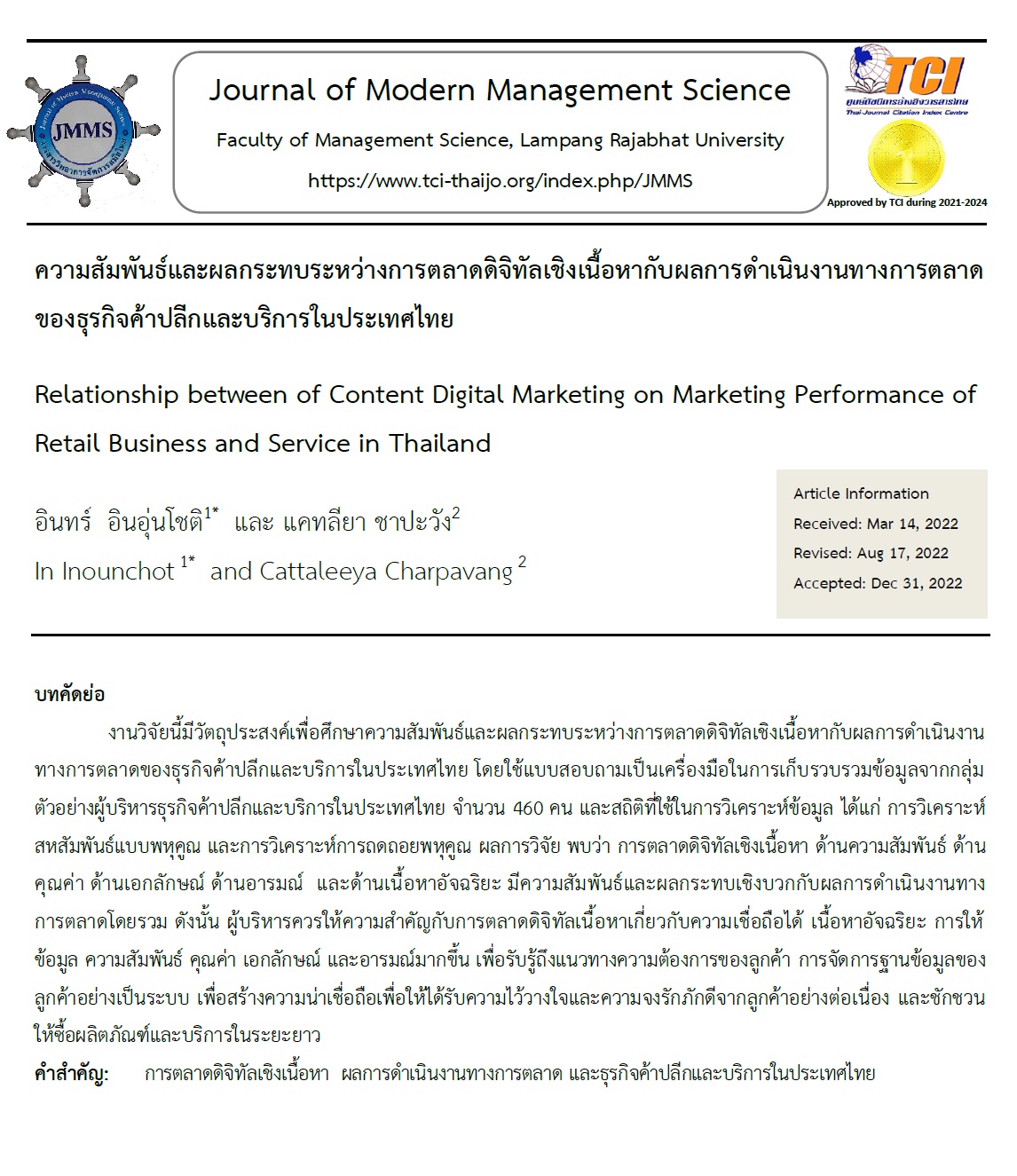Relationship between of Content Digital Marketing on Marketing Performance of Retail Business and Service in Thailand
Main Article Content
Abstract
The objective of this research is to test the relations between effect of content digital marketing on marketing performance of retail business and service in Thailand. Questionnaires were used as a tool for collecting data from 460 executive of retail business and service in Thailand. The statistics used for analyzing the collected data included were multiple correlation analysis and multiple regression analysis. The results showed that content digital marketing in the aspects of relationship, value, identity, emotion and intelligent content overall has a positive effect with overall marketing performance of retail business and service in Thailand. Consequently, the executive of retail business and service in Thailand should focus more on content digital marketing on reliability, intelligent content, information, relationship, value, identity and emotion in order to perceive the customer’s feedbacks, to systematically managing the customer’s database, to build reliability so they could constantly gain the trust and loyalty from the customers and persuade them to repurchase the product and service in the long term.
Article Details

This work is licensed under a Creative Commons Attribution-NonCommercial-NoDerivatives 4.0 International License.
The article must be considered and accepted for publication by the editorial board of the Faculty of Management Science, Lampang Rajabhat University. The articles have been reviewed by a peer (peer review) and the author must update according to the suggestion if available before publication. Articles that are not considered the editorial team will inform the results of the consideration but will not send the original to the author.
JMMS is the Faculty of Management Science journal, Lampang Rajabhat University. Jmms published both print and online editions. We allow the use of articles for academic use under the scope of copyright law.
References
กรมพัฒนาธุรกิจการค้า. (2563). ข้อมูลทั่วไปผู้ประกอบการธุรกิจค้าปลีกและบริการในประเทศไทย. [ออนไลน์]. สืบค้นเมื่อวันที่ 20 กันยายน 2563 เข้าถึงจาก https://www.dbd.go.th/
บริษัท พีเอ็มจี คอร์ปอเรชั่น จำกัด. (2562). Smart SME รวมข้อมูลข่าวสาร เพื่อธุรกิจเอสเอ็มอี. กรุงเทพฯ: บริษัท พีเอ็มจี คอร์ปอเรชั่น จำกัด.
พรพรรณ ตาลประเสริฐ. (2562). อิทธิพลของการตลาดแบบดิจิทัลต่อการตัดสินใจซื้อของผู้บริโภคกลุ่มธุรกิจการพาณิชย์อิเล็กทรอนิกส์ในเขตจังหวัดกรุงเทพมหานคร. วิทยานิพนธ์บริหารธุรกิจมหาบัณฑิต มหาวิทยาลัยกรุงเทพ.
ราม ปิยะเกตุ มาโนช โลหเตปานนท์ และธวัชชัย ชรินพาณิชกุล. (2564). โครงการศึกษาวิเคราะห์พัฒนาการของ ผู้ประกอบการพาณิชย์อิเล็กทรอนิกส์. กรุงเทพฯ: เนชั่น,
ราม ปิยะเกตุ, พิสุทธิ์ เพียรมนกุล, มาโนช โลหเตปานนท์, ธวัชชัย ชรินพาณิชกุล และชัยเชษฐ์ สายวิจิตร. (2555). วิเคราะห์พัฒนาการของผู้ประกอบการธุรกิจค้าปลีกและค้าส่งในประเทศไทย. กรุงเทพฯ: เนชั่น,
ศูนย์วิเคราะห์เศรษฐกิจทีเอ็มบี. (2564). ธุรกิจค้าปลีกกับช่องทางออนไลน์เชื่อมต่อผู้บริโภค. กรุงเทพฯ: ศูนย์วิเคราะห์เศรษฐกิจทีเอ็มบี.
ศูนย์วิจัยกสิกรไทย. (2563). เศรษฐกิจไทยไตรมาส 2/2563 คาดหดตัวลุกสุดในปีนี้ แต่ครึ่งปีหลังยังคงมีความเสี่ยงสูงและยังต้องติดตามมาตรการเพิ่มเติม (มองเศรษฐกิจ ฉบับที่ 3880). กรุงเทพฯ : ศูนย์วิจัยกสิกรไทย.
สำนักงานนวัตกรรมแห่งชาติ. (2564) . แนวโน้มการขยายตัวทางเศรษฐกิของประเทศไทย. กรุงเทพฯ: สำนักงานนวัตกรรมแห่งชาติ.
สุภาภรณ์ อุดมลักษณ์. (2560). การพัฒนารูปแบบการบริหารจัดการการใช้เทคโนโลยี สารสนเทศและการสื่อสาร ของวิทยาลัยพยาบาล สังกัดสถาบันพระบรมราชชนก, Nursing Journal of The Ministry of Public Health, 27(1), 113-125.
อโณทัย งามวิชัยกิจ. (2563). การสื่อสารการตลาดผ่านสื่อสังคมที่มีผลต่อความผูกพันของนักศึกษาต่อตราผลิตภัณฑ์มหาวิทยาลัย กรณีศึกษามหาวิทยาลัยสุโขทัยธรรมาธิราช, วารสารวิชาการนวัตกรรมสื่อสารสังคม. 7(2) : 94-105.
Aaker, D. A. (2001). Consumer Evaluations of Brand Extensions, Journal of Marketing, 54(1), 27–41.
Abel, U. (2014). Benson, Cutting-Edge Technologies and Social Media Use in Higher Education. International Journal of Information Management, 24(1), 236-252.
Ambler, T., & Kokkinaki, F. (2014). Measures of marketing success. Journal of Marketing Management, 13(7), 37-41.
Ausra, K. & Ruta, M. (2016). Biotechnological Wastewater Treatment in Small-scale Wastewater Treatment Plants, Journal of Cleaner Production. 279, 123750.
Berger, B. and Milkman, G. (2010). The Process of Customer Engagement: A Conceptual Framework. The Journal of Marketing Theory and Practice, 17(1), 63–74.
Berkle, B.J. (2010). Analyzing Service Blueprints Using Phase Distributions. European Journal of Operational Research, 88(1), 152-164.
Bertrand, M., Goldin, C. & Katz, L. (2010). Dynamics of the Gender Gap for Young Professionals in the Financial and Corporate Sectors. American Economic Journal Applied Economics, 2(3), 228-55.
Black, K. (2006). Business Statistics for Contemporary Decision Marking. (4th ed.) USA : John Wiley & Sons. pp. 585.
Cernikovaite, J. (2012). Digital Content Marketing's Role in Fostering Consumer Engagement, Trust, and Value: Framework, Fundamental Propositions, and Implications. Journal of Interactive Marketing, 45, 27-41.
Chasser, T. K., Zheng, X., Christy, C. & Lee, O. (2010). Antecedents and Consequences of Customer Engagement in Online Brand Communities. Journal of Marketing Analytics, 2(2), 81–97.
Gagnon, J. (2014). Demographic Change and the Future of the Labour Force in the EU27, in other OECD Countries and Selected Large Emerging Economies. Matching Economic Migration with Labour Market Needs, OECD Publishing, Paris.
Hanbury, K. (2015). Steps to Creating an Effective Content Mix. The Journal of Marketing Theory and Practice, Retrieved from http://contentmarketinginstitute.com/2011/02/content-mix/
Javornik, A., Raffaele, F. & Gumann, R. (2020). Don't Forget that Others Are Watching, Tool. The Effect of Conversational Human Voice and Reply Length on Observers' Perceptions of Complaint Handling in Social Media. Journal of Interactive Marketing, 50, 100-119.
Kapoor, E., Johanne, M. P., Lajeunesse, D., Pelletier, J. P. & Fahmi, H. (2018). Role of Prion Flam Matory Cytokines in the Pathophysiology of Osteoarthritis. Nature Reviews Rheumatology, 7, 33–42.
Kaur, K. L., Hong-Bumm, K., Woo G. K. and Jeong A. (2018). Strategic Brand Online : Building, Measuring, and Managing Brand Equity. (2nd ed.) Englewood Cliffs, NJ., Prentice Hall.
Lal, M., Wang, W. H. and Jillian, D. & Farquhar, S. (2020). Soil Carbon Sequestration Impacts on Global Climate Change and Food Security. Journal of Interactive Marketing, 52(3), 99-117.
Limba, J. (2013). Trust and Power: Two Works by Niklas Luhman. New York: John Wiley & Sons.
Lin, R. J., Lewicki, R.J., McAllister, D.J. & Bies, R.J. (2014). Trust and Distrust: New Relationships and Digital Marketing. The Academy of Management Review, 23(3), 438-459.
Ludwig, J., Liebman, J.B., Kling, J.R., Duncan, G.J. Katz, L.F. & Kessler, R.C. (2012). What Can We Learn about Neighborhood Effects from the Moving to Opportunity Experiment. American Journal of Sociology, 114, 144–188.
Nunnally, J.C. (1978). Psychometric Theory. (2nd ed.) McGraw-Hill, New York.
Ruzkevicius, R. & Guseva, G. (2006). Generalized Expectancies for Interpersonal Trust. American Psychologist, 26(5), 443-452.
Statista, S. (2020). Examining Relational Digital Transformation Through the Unfolding of Local Practices of the Finnish Taxi Industry. The Journal of Strategic Information System, 29(3), 101622.
Wertime, K. & Fenwick, I. (2017). Open Word on Digital Marketing. New York: Price.
Wolf, N. (2010). Marketing to win: Strategies for building competitive advantage in service industries: Frank K. Sonnenberg Grand Rapids: Harper Business. Public Relations Review, 17(2), 205-206.
Zhao, S., Zhang, J. & Leeb, J. (2021). Internet Market Strategies: Antecedents and Implications. Information and Management, 43(2), 222-238.


